Abstract
1. The effects of dopamine on the sensory discharges originating from arterial chemo- and baroreceptors were studied in vitro using carotid bodies or sinuses excised from anaesthetized cats and superfused with Locke's solution. 2. Intrastream injections of dopamine 10-200 mug produced a transient depression of the frequency of chemoreceptor discharges. This effect was observed in response to the first injection in eighteen out of twenty preparations. 3. The inhibitory effect of dopamine can counteract partially or totally the excitation of chemoreceptors evoked by simultaneous application of acetylcholine or cyanide. 4. This inhibitory effect of dopamine is reduced or abolished by pretreatment with dopaminergic (Spiroperidol) or alpha-adrenergic (Dibenamine) blockers. 5. In response to repeated injections of dopamine applied at short intervals, the inhibitory effect is replaced by a biphasic effect (early inhibition followed by late excitation), a late and long-lasting excitation or no changes in chemoreceptor activity. The late excitatory effects of dopamine are not blocked by dopaminergic or alpha-adrenergic blockers. 6. Noradrenaline does not affect the chemoreceptor activity of the superfused carotid body. DL-DOPA induces only a late and long-lasting excitatory effect. 7. In carotid sinus preparations, dopamine induces a weak but long-lasting increase in the frequency of baroreceptor discharges. 8. It is concluded that dopamine may play a modulatory role in the generation of chemoreceptor activity through local regulatory processes.
Full text
PDF
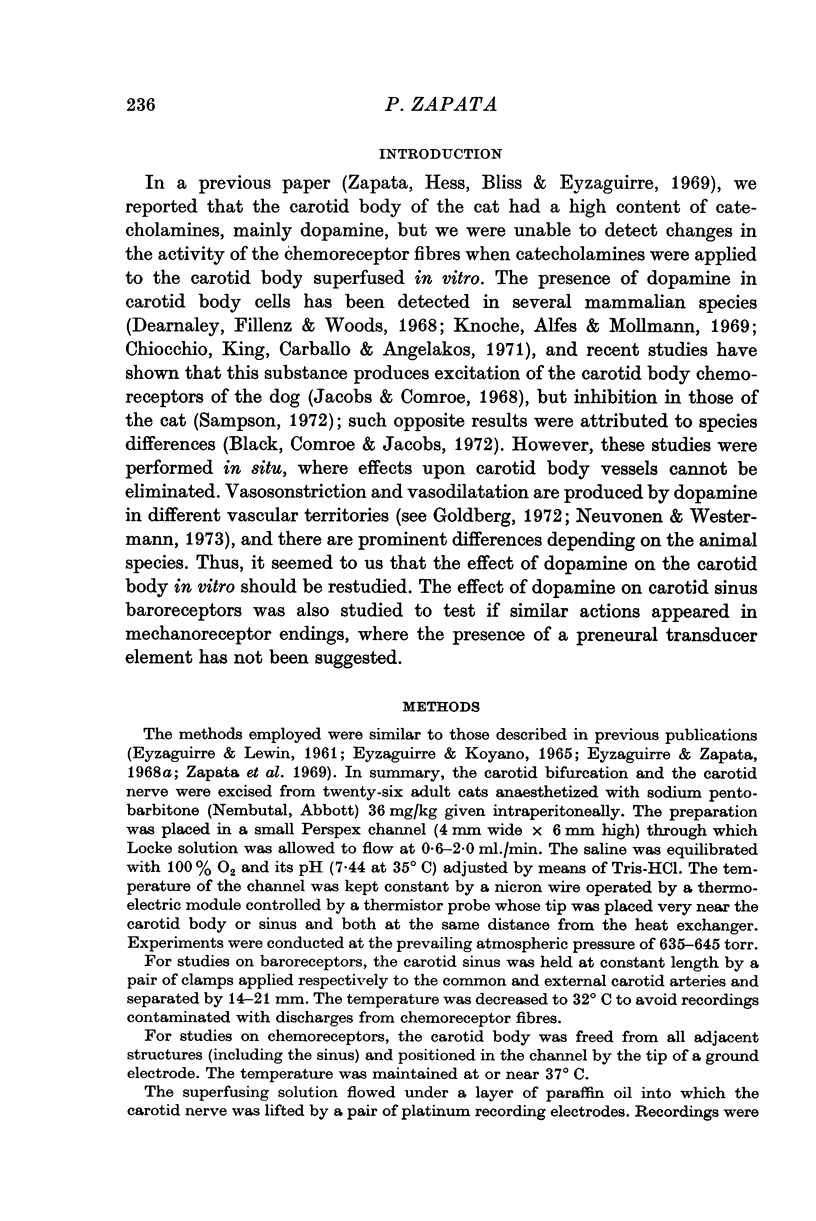
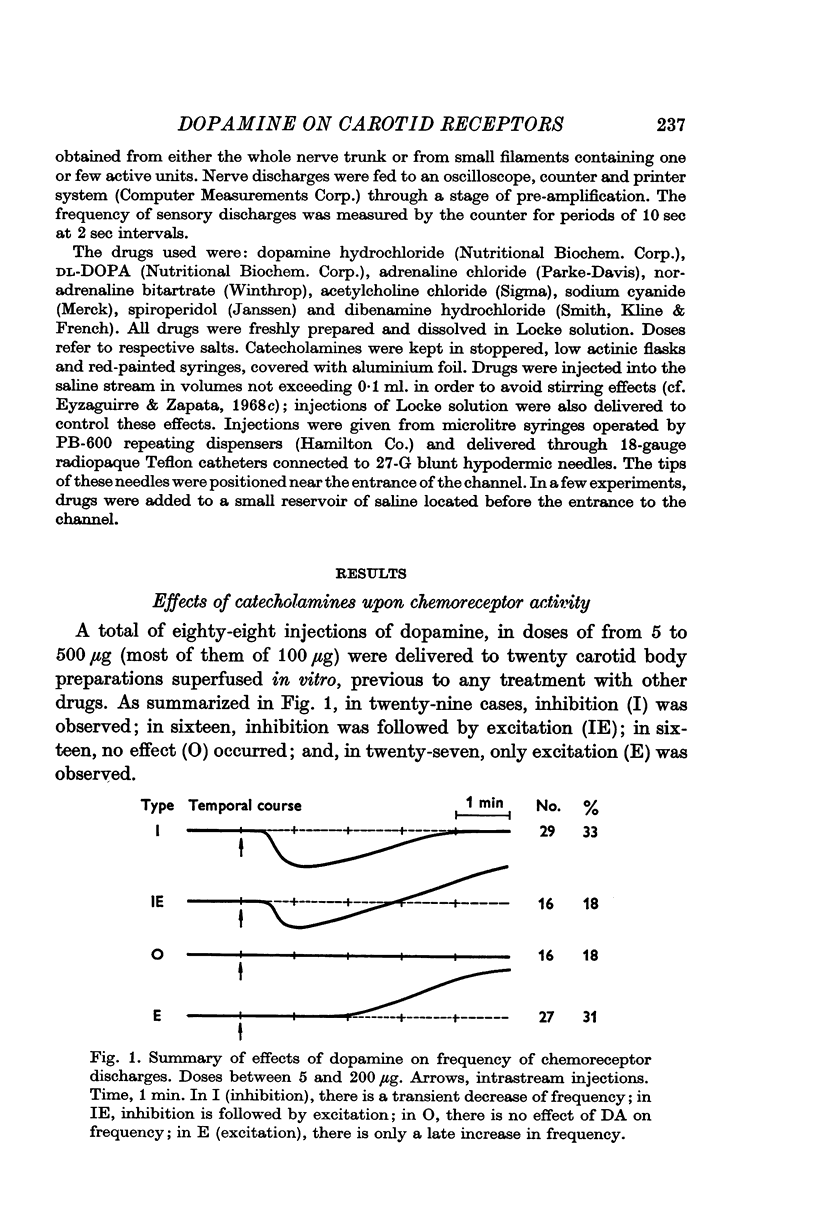
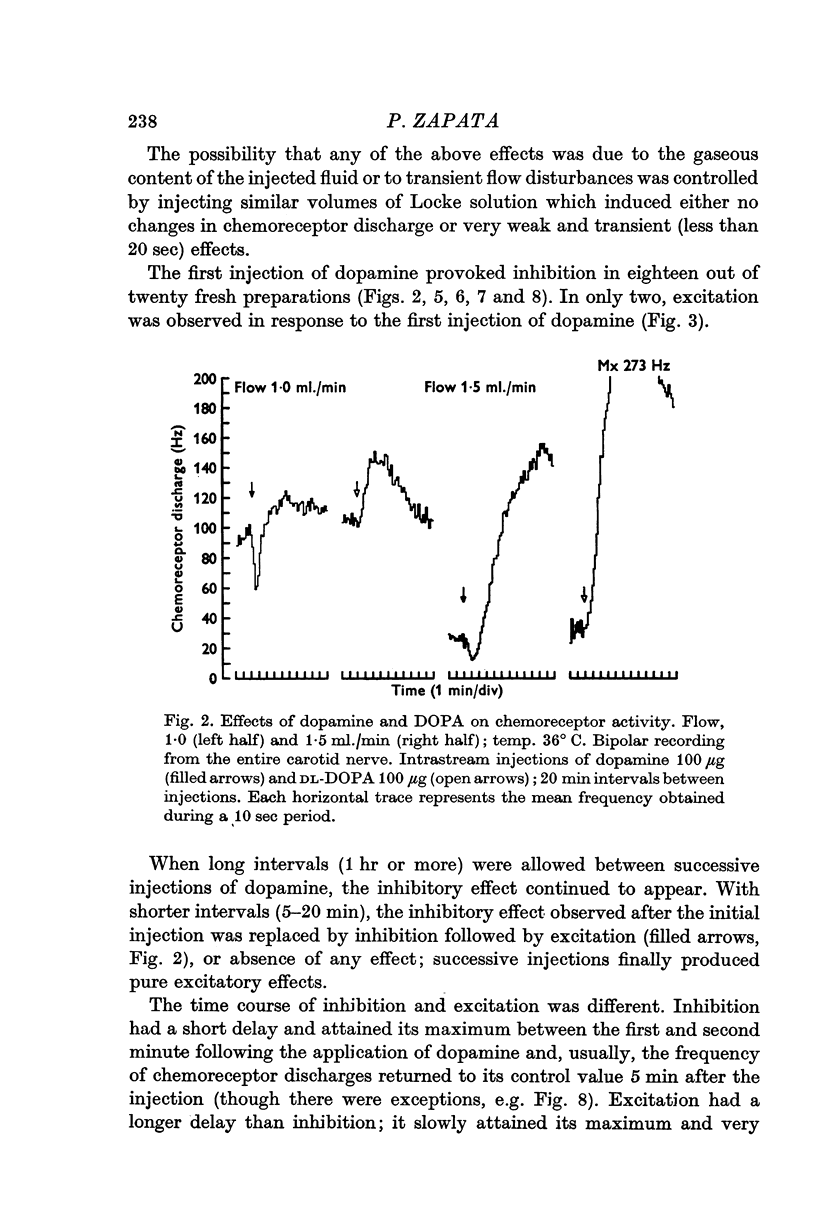
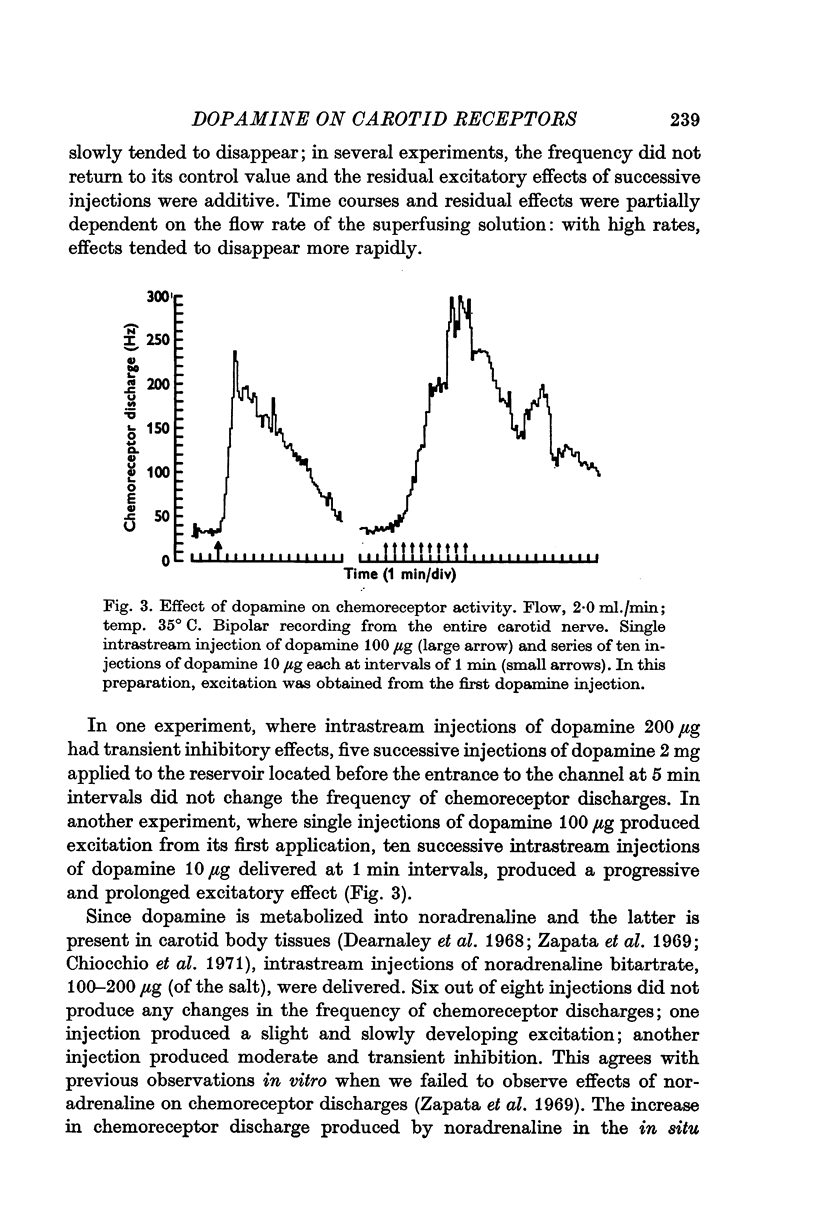
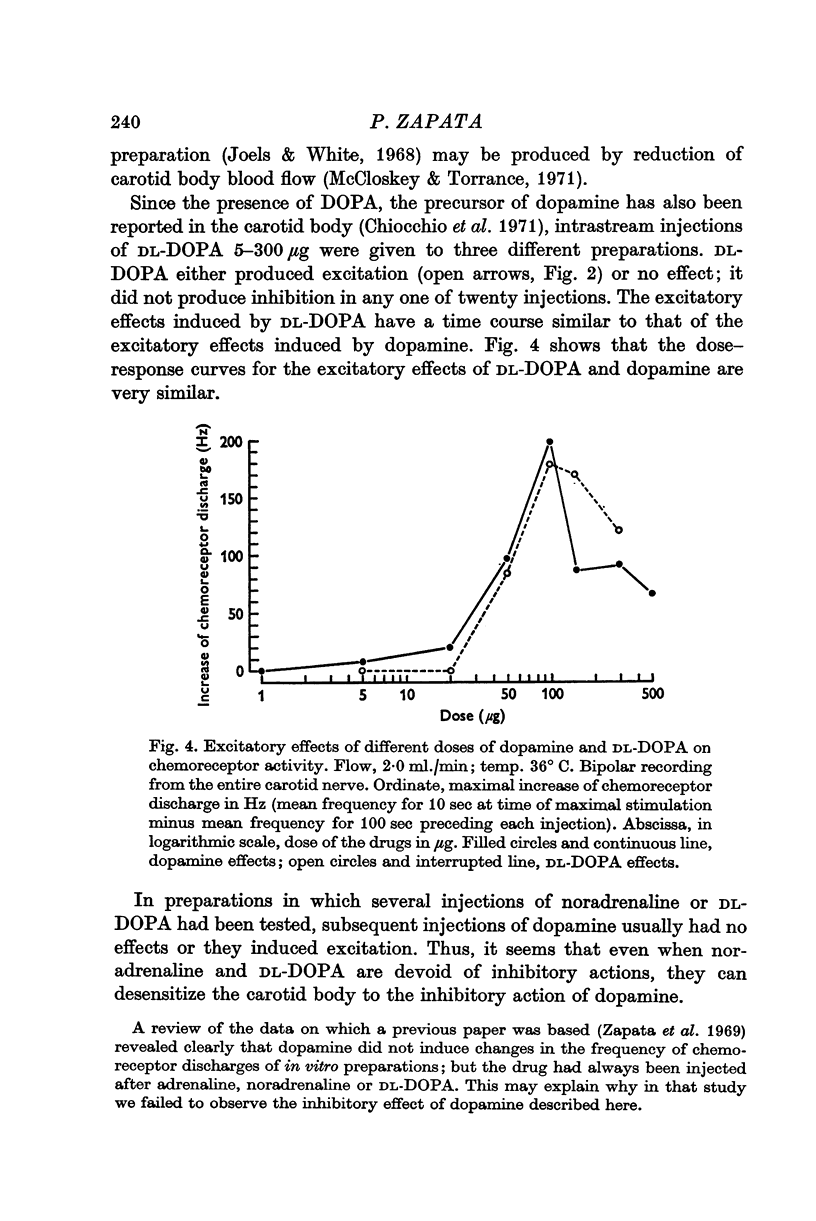
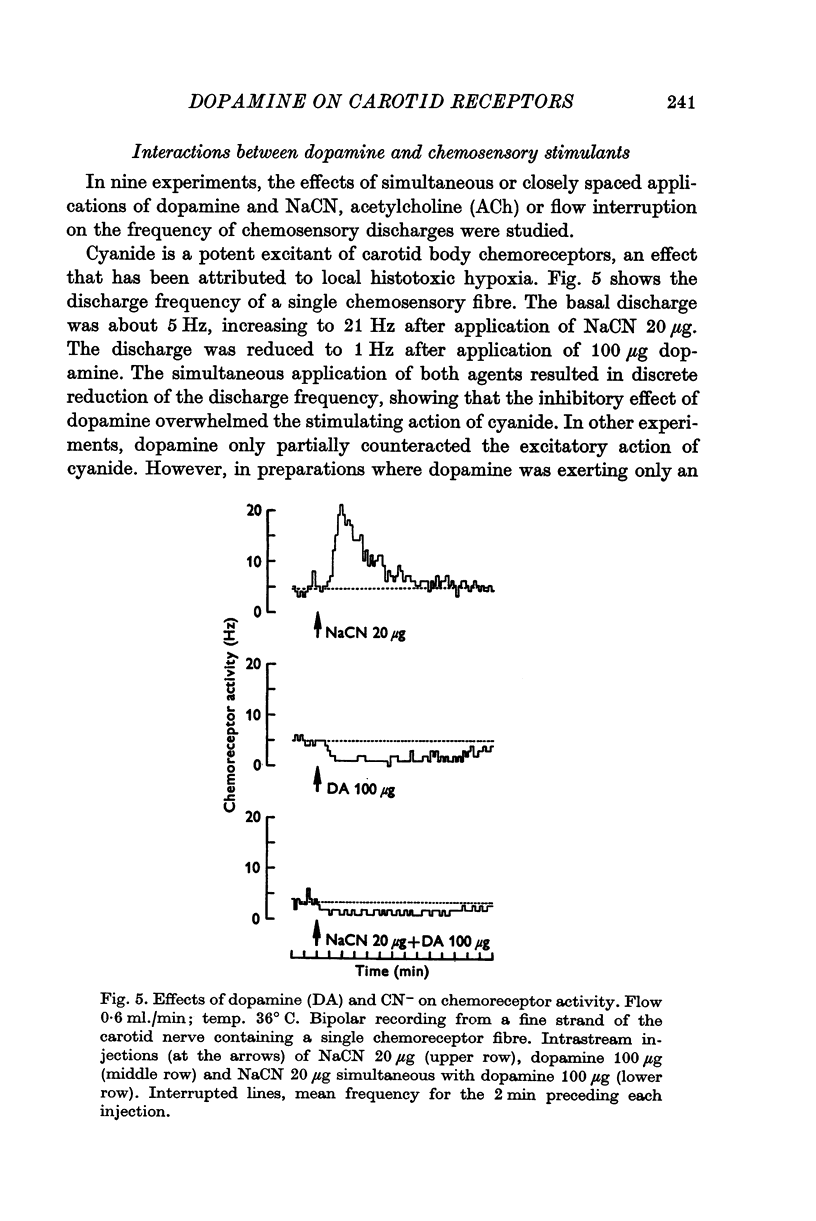

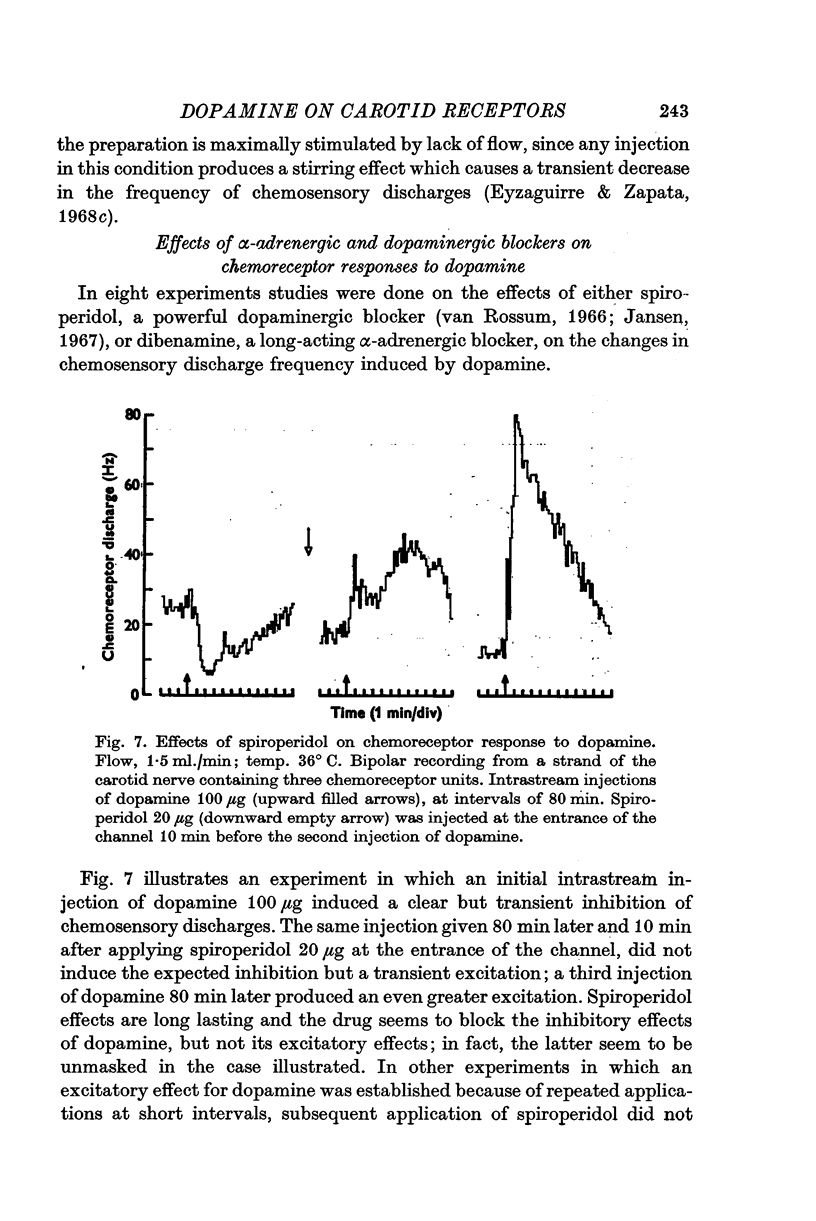
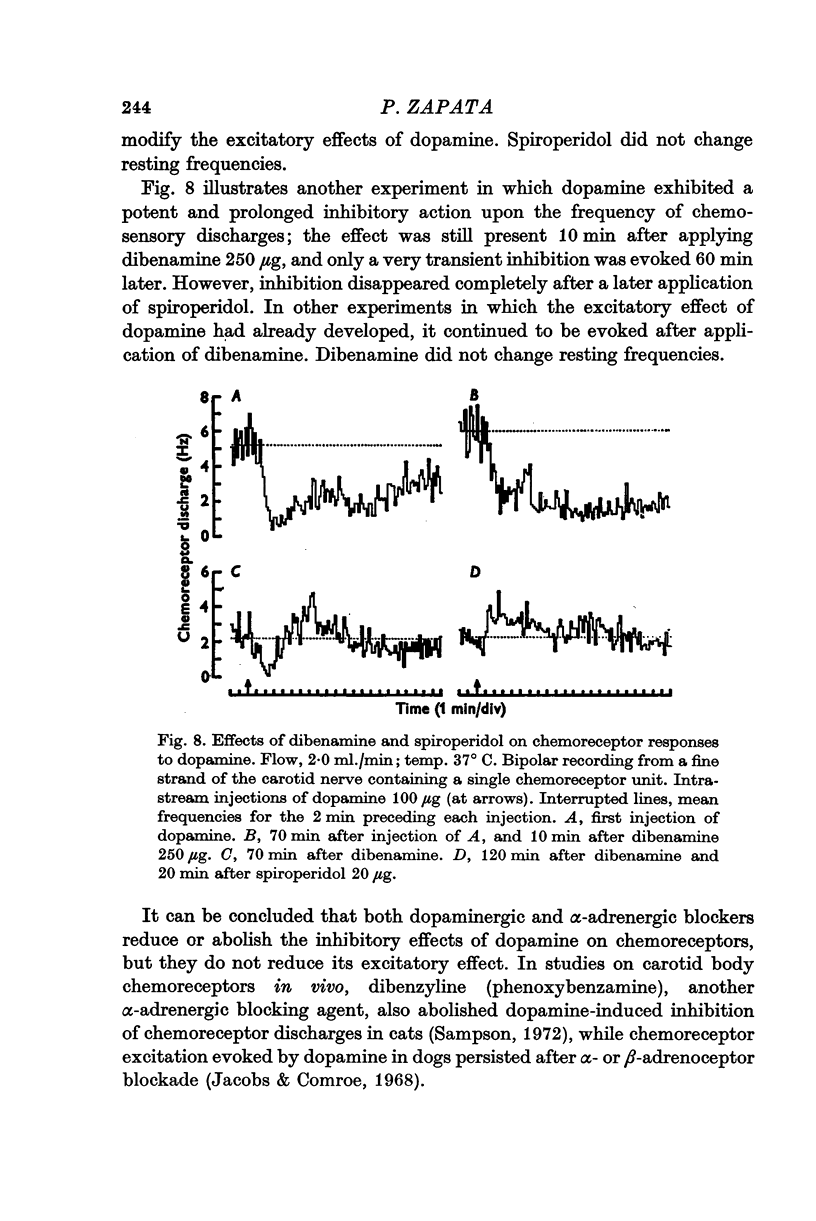
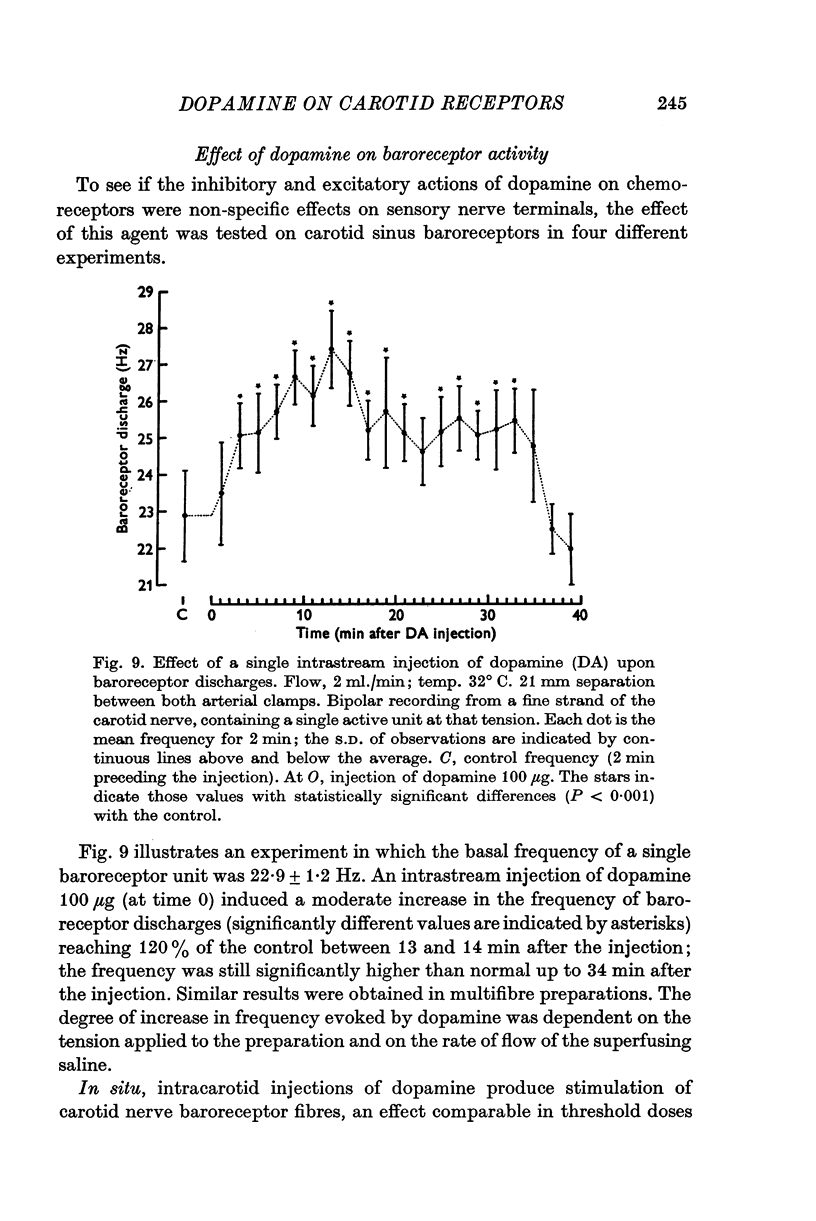

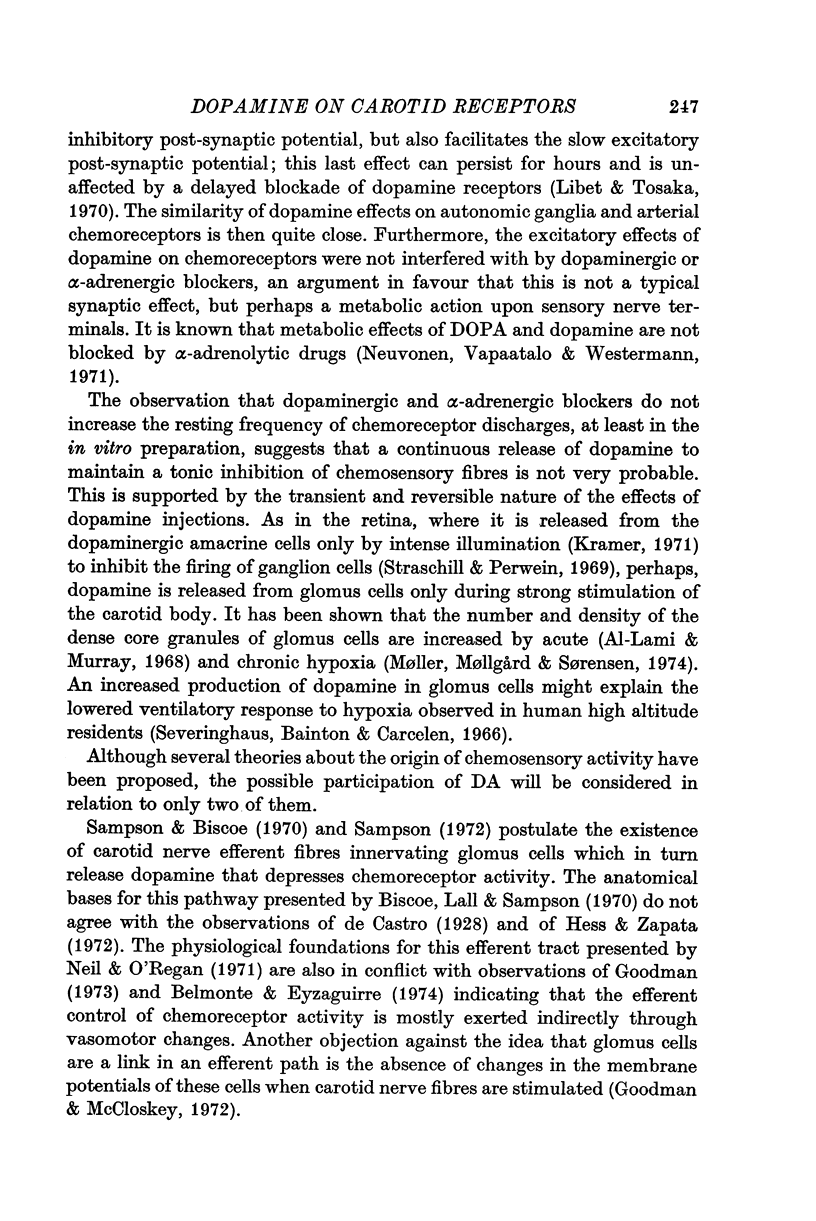
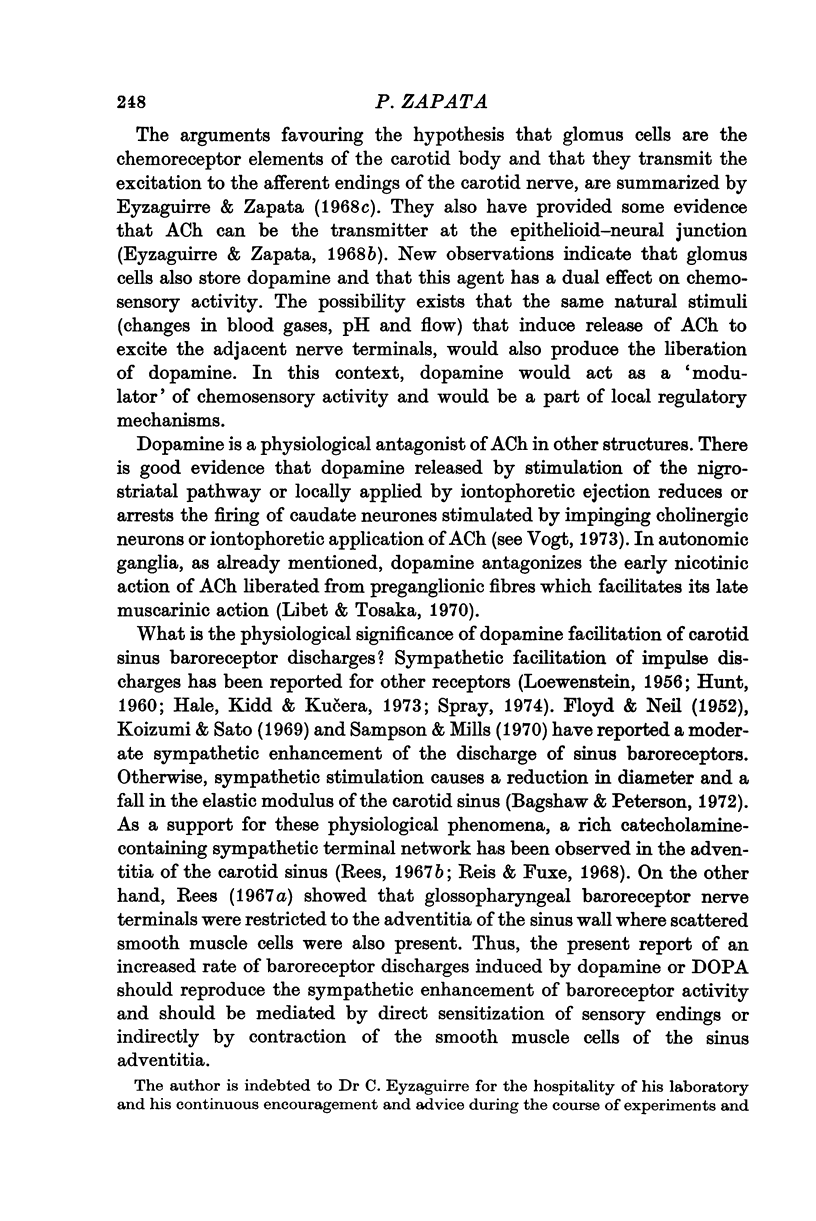
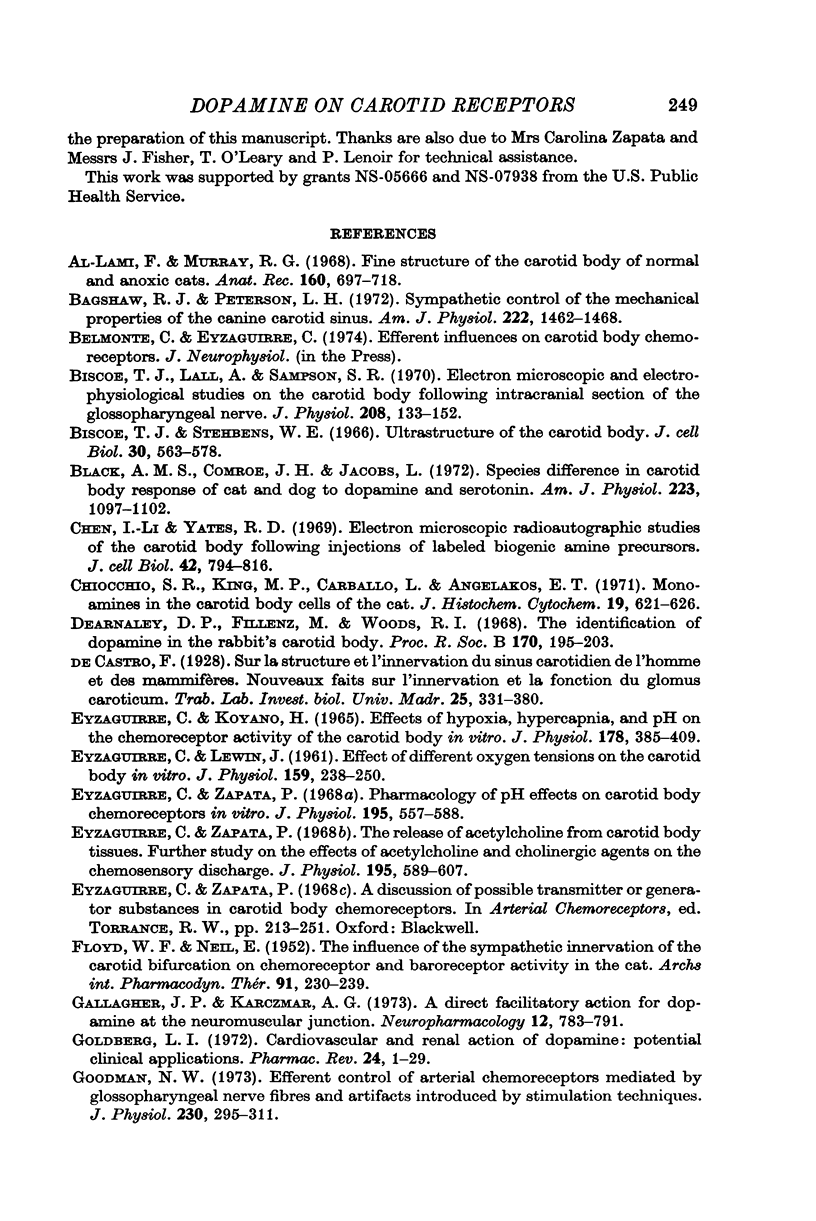

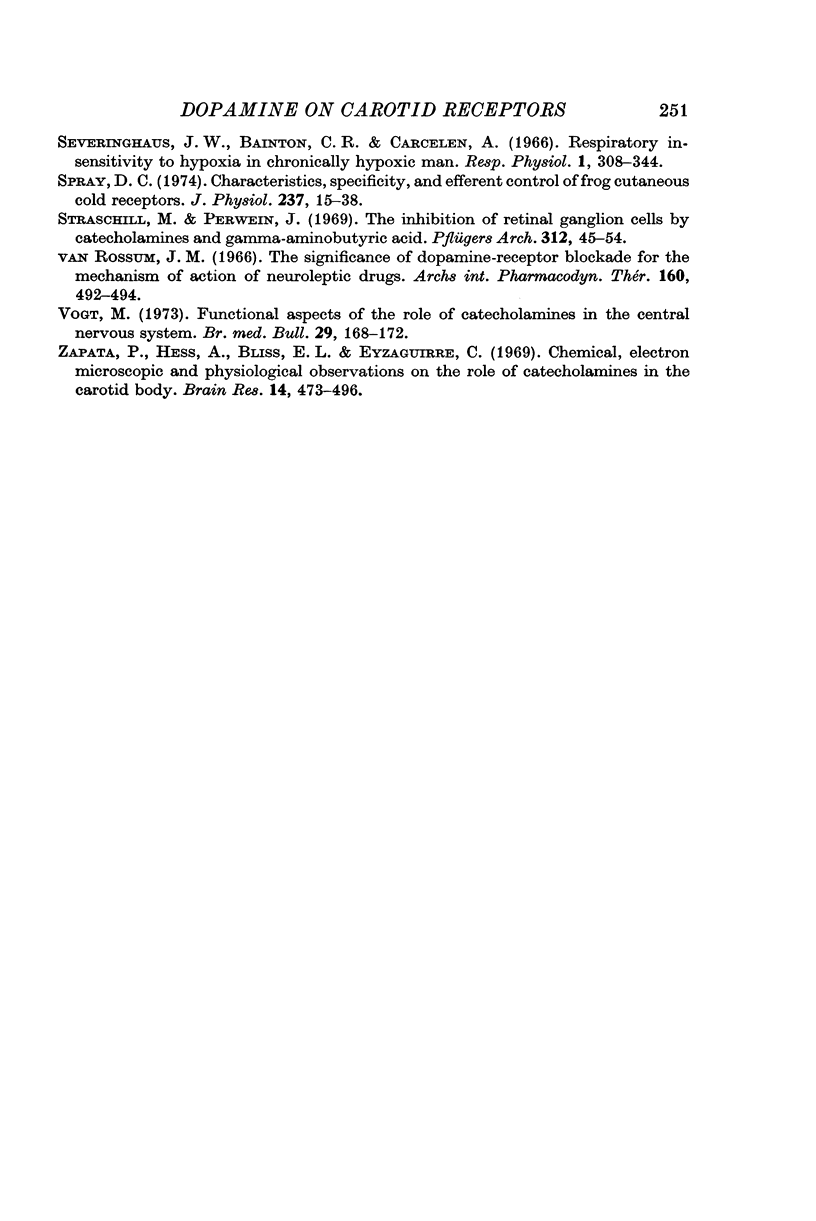
Selected References
These references are in PubMed. This may not be the complete list of references from this article.
- Bagshaw R. J., Peterson L. H. Sympathetic control of the mechanical properties of the canine carotid sinus. Am J Physiol. 1972 Jun;222(6):1462–1468. doi: 10.1152/ajplegacy.1972.222.6.1462. [DOI] [PubMed] [Google Scholar]
- Biscoe T. J., Lall A., Sampson S. R. Electron microscopic and electrophysiological studies on the carotid body following intracranial section of the glossopharyngeal nerve. J Physiol. 1970 May;208(1):133–152. doi: 10.1113/jphysiol.1970.sp009110. [DOI] [PMC free article] [PubMed] [Google Scholar]
- Biscoe T. J., Stehbens W. E. Ultrastructure of the carotid body. J Cell Biol. 1966 Sep;30(3):563–578. doi: 10.1083/jcb.30.3.563. [DOI] [PMC free article] [PubMed] [Google Scholar]
- Black A. M., Comroe J. H., Jr, Jacobs L. Species difference in carotid body response of cat and dog to dopamine and serotonin. Am J Physiol. 1972 Nov;223(5):1097–1102. doi: 10.1152/ajplegacy.1972.223.5.1097. [DOI] [PubMed] [Google Scholar]
- Chen I. L., Yates R. D. Electron microscopic radioautographic studies of the carotid body following injections of labeled biogenic amine precursors. J Cell Biol. 1969 Sep;42(3):794–803. doi: 10.1083/jcb.42.3.794. [DOI] [PMC free article] [PubMed] [Google Scholar]
- Chiocchio S. R., King M. P., Carballo L., Angelakos E. T. Monoamines in the carotid body cells of the cat. J Histochem Cytochem. 1971 Oct;19(10):621–626. doi: 10.1177/19.10.621. [DOI] [PubMed] [Google Scholar]
- Dearnaley D. P., Fillenz M., Woods R. I. The identification of dopamine in the rabbit's carotid body. Proc R Soc Lond B Biol Sci. 1968 Jun 11;170(1019):195–203. doi: 10.1098/rspb.1968.0033. [DOI] [PubMed] [Google Scholar]
- EYZAGUIRRE C., LEWIN J. Effect of different oxygen tensions on the carotid body in vitro. J Physiol. 1961 Dec;159:238–250. doi: 10.1113/jphysiol.1961.sp006805. [DOI] [PMC free article] [PubMed] [Google Scholar]
- Eyzaguirre C., Koyano H. Effects of hypoxia, hypercapnia, and pH on the chemoreceptor activity of the carotid body in vitro. J Physiol. 1965 Jun;178(3):385–409. doi: 10.1113/jphysiol.1965.sp007634. [DOI] [PMC free article] [PubMed] [Google Scholar]
- Eyzaguirre C., Zapata P. Pharmacology of pH effects on carotid body chemoreceptors in vitro. J Physiol. 1968 Apr;195(3):557–588. doi: 10.1113/jphysiol.1968.sp008474. [DOI] [PMC free article] [PubMed] [Google Scholar]
- Eyzaguirre C., Zapata P. The release of acetylcholine from carotid body tissues. Further study on the effects of acetylcholine and cholinergic blocking agents on the chemosensory discharge. J Physiol. 1968 Apr;195(3):589–607. doi: 10.1113/jphysiol.1968.sp008475. [DOI] [PMC free article] [PubMed] [Google Scholar]
- FLOYD W. F., NEIL E. The influence of the sympathetic innervation of the carotid bifurcation on chemoceptor and baroceptor activity in the cat. Arch Int Pharmacodyn Ther. 1952 Sep 1;91(1-2):230–239. [PubMed] [Google Scholar]
- Gallagher J. P., Karczmar A. G. A direct facilitatory action for dopamine at the neuromuscular junction. Neuropharmacology. 1973 Aug;12(8):783–791. doi: 10.1016/0028-3908(73)90019-1. [DOI] [PubMed] [Google Scholar]
- Goldberg L. I. Cardiovascular and renal actions of dopamine: potential clinical applications. Pharmacol Rev. 1972 Mar;24(1):1–29. [PubMed] [Google Scholar]
- Goodman N. W. Efferent control of arterial chemoreceptors mediated by glossopharyngeal fibres and artifacts introduced by stimulation techniques. J Physiol. 1973 Apr;230(2):295–311. doi: 10.1113/jphysiol.1973.sp010189. [DOI] [PMC free article] [PubMed] [Google Scholar]
- Goodman N. W., McCloskey D. I. Intracellular potentials in the carotid body. Brain Res. 1972 Apr 28;39(2):501–504. doi: 10.1016/0006-8993(72)90452-0. [DOI] [PubMed] [Google Scholar]
- HUNT C. C. The effect of sympathetic stimulation on mammalian muscle spindles. J Physiol. 1960 May;151:332–341. doi: 10.1113/jphysiol.1960.sp006441. [DOI] [PMC free article] [PubMed] [Google Scholar]
- Hess A., Zapata P. Innervation of the cat carotid body: normal and experimental studies. Fed Proc. 1972 Sep-Oct;31(5):1365–1382. [PubMed] [Google Scholar]
- Jacobs L., Comroe J. H., Jr Stimulation of the carotid chemoreceptors of the dog by dopamine. Proc Natl Acad Sci U S A. 1968 Apr;59(4):1187–1193. doi: 10.1073/pnas.59.4.1187. [DOI] [PMC free article] [PubMed] [Google Scholar]
- Joels N., White H. The contribution of the arterial chemoreceptors to the stimulation of respiration by adrenaline and noradrenaline in the cat. J Physiol. 1968 Jul;197(1):1–23. doi: 10.1113/jphysiol.1968.sp008541. [DOI] [PMC free article] [PubMed] [Google Scholar]
- Knoche H., Alfes H., Möllmann H. On the biogenic amines in the carotid body: identification of dopamine by mass spectrometry. Experientia. 1969 May 15;25(5):515–516. doi: 10.1007/BF01900793. [DOI] [PubMed] [Google Scholar]
- Koizumi K., Sato A. Influence of sympathetic innervation on carotid sinus baroreceptor activity. Am J Physiol. 1969 Feb;216(2):321–329. doi: 10.1152/ajplegacy.1969.216.2.321. [DOI] [PubMed] [Google Scholar]
- Kramer S. G. Dopamine: A retinal neurotransmitter. I. Retinal uptake, storage, and light-stimulated release of H3-dopamine in vivo. Invest Ophthalmol. 1971 Jun;10(6):438–452. [PubMed] [Google Scholar]
- Libet B., Tosaka T. Dopamine as a synaptic transmitter and modulator in sympathetic ganglia: a different mode of synaptic action. Proc Natl Acad Sci U S A. 1970 Oct;67(2):667–673. doi: 10.1073/pnas.67.2.667. [DOI] [PMC free article] [PubMed] [Google Scholar]
- McCloskey D. I., Torrance R. W. Autoregulation of blood flow in the carotid body. Respir Physiol. 1971 Oct;13(1):23–35. doi: 10.1016/0034-5687(71)90062-4. [DOI] [PubMed] [Google Scholar]
- Moller M., Mollgård K., Sorensen S. C. The ultrastructure of the carotid body in chronically hypoxic rabbits. J Physiol. 1974 May;238(3):447–453. doi: 10.1113/jphysiol.1974.sp010536. [DOI] [PMC free article] [PubMed] [Google Scholar]
- Neil E., O'Regan R. G. The effects of electrical stimulation of the distal end of the cut sinus and aortic nerves on peripheral arterial chemoreceptor activity in the cat. J Physiol. 1971 May;215(1):15–32. doi: 10.1113/jphysiol.1971.sp009455. [DOI] [PMC free article] [PubMed] [Google Scholar]
- Neuvonen P. J., Westermann E. On the cardiovascular action of dopamine in rats. Naunyn Schmiedebergs Arch Pharmacol. 1973;280(4):363–371. doi: 10.1007/BF00506629. [DOI] [PubMed] [Google Scholar]
- Rees P. M. Observations on the fine structure and distribution of presumptive baroreceptor nerves at the carotid sinus. J Comp Neurol. 1967 Dec;131(4):517–548. doi: 10.1002/cne.901310409. [DOI] [PubMed] [Google Scholar]
- Rees P. M. The distribution of biogenic amines in the carotid bifurcation region. J Physiol. 1967 Nov;193(2):245–253. doi: 10.1113/jphysiol.1967.sp008355. [DOI] [PMC free article] [PubMed] [Google Scholar]
- Reis D. J., Fuxe K. Adrenergic innervation of the carotid sinus. Am J Physiol. 1968 Nov;215(5):1054–1057. doi: 10.1152/ajplegacy.1968.215.5.1054. [DOI] [PubMed] [Google Scholar]
- Sampson S. R., Biscoe T. J. Efferent control of the carotid body chemoreceptor. Experientia. 1970 Mar 15;26(3):261–262. doi: 10.1007/BF01900082. [DOI] [PubMed] [Google Scholar]
- Sampson S. R. Mechanism of efferent inhibition of carotid body chemoreceptors in the cat. Brain Res. 1972 Oct 13;45(1):266–270. doi: 10.1016/0006-8993(72)90236-3. [DOI] [PubMed] [Google Scholar]
- Sampson S. R., Mills E. Effects of sympathetic stimulation on discharges of carotid sinus baroreceptors. Am J Physiol. 1970 Jun;218(6):1650–1653. doi: 10.1152/ajplegacy.1970.218.6.1650. [DOI] [PubMed] [Google Scholar]
- Severinghaus J. W., Bainton C. R., Carcelen A. Respiratory insensitivity to hypoxia in chronically hypoxic man. Respir Physiol. 1966;1(3):308–334. doi: 10.1016/0034-5687(66)90049-1. [DOI] [PubMed] [Google Scholar]
- Spray D. C. Characteristics, specificity, and efferent control of frog cutaneous cold receptors. J Physiol. 1974 Feb;237(1):15–38. doi: 10.1113/jphysiol.1974.sp010467. [DOI] [PMC free article] [PubMed] [Google Scholar]
- Straschill M., Perwein J. The inhibition of retinal ganglion cells by catecholeamines and gamma-aminobutyric acid. Pflugers Arch. 1969;312(3):45–54. doi: 10.1007/BF00588530. [DOI] [PubMed] [Google Scholar]
- Vogt M. Functional aspects of the role of catecholamines in the central nervous system. Br Med Bull. 1973 May;29(2):168–172. doi: 10.1093/oxfordjournals.bmb.a070989. [DOI] [PubMed] [Google Scholar]
- Zapata P., Hess A., Bliss E. L., Eyzaguirre C. Chemical, electron microscopic and physiological observations on the role of catecholamines in the carotid body. Brain Res. 1969 Jul;14(2):473–496. doi: 10.1016/0006-8993(69)90123-1. [DOI] [PubMed] [Google Scholar]
- el-Lami F., Murray R. G. Fine structure of the carotid body of normal and anoxic cats. Anat Rec. 1968 Apr;160(4):697–718. doi: 10.1002/ar.1091600405. [DOI] [PubMed] [Google Scholar]


